Hey! By the way… TheEdibleTerrace is reader-supported. When you buy through links on our site, we may earn an affiliate commission and as an Amazon affiliate, we earn from qualifying purchases. Thanks in advance for your support!
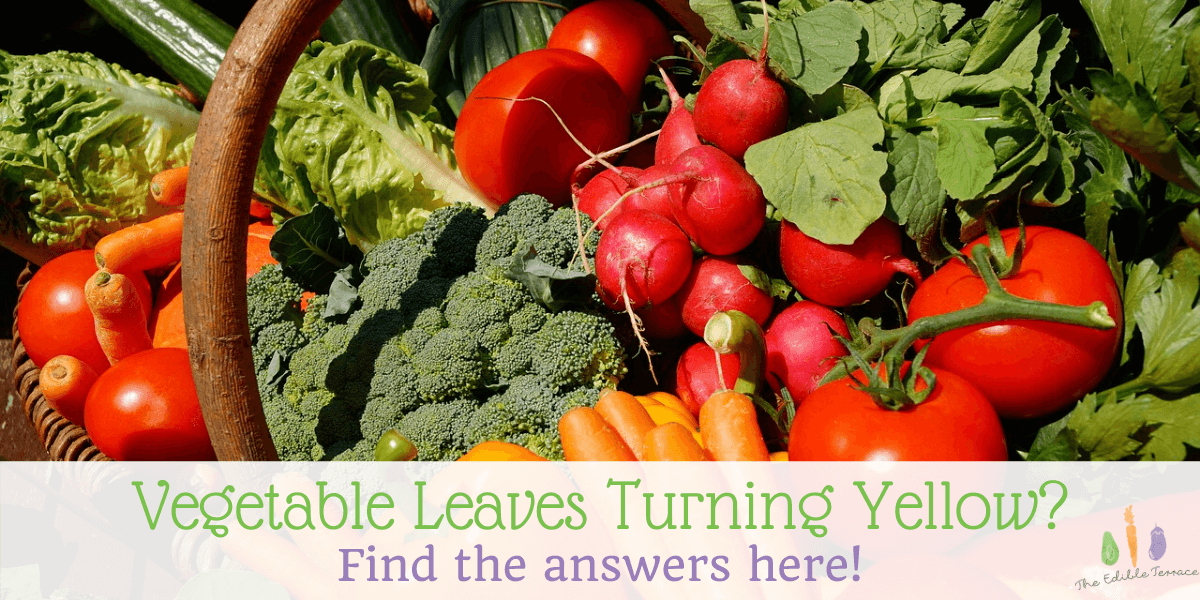
Are your vegetable plant leaves turning yellow? My itty bitty pot of strawberry leaves turns yellow all the time. Same with my bell peppers. Your garden plants turning yellow is definitely indicative of a problem. That problem is one of a few things: nutrient deficiency, pests, overwatering, under watering, not enough sun so stay with me through the end of this post and we will get this fixed together!
Why are my vegetable plant leaves turning yellow?
Nutrient Deficiency
A condition called ‘Chlorosis’ is what causes your leaves to yellow. This is due to a lack of chlorophyll. The three main nutrient deficiencies that cause chlorosis are nitrogen, potassium and iron. There are others but those are the primary culprits.
Nitrogen Deficiency
You can tell if the issue is a nitrogen deficiency because the chlorosis (yellowing) normally appears at the base of the plant then moves up the stem to the leaves. According to my BF’s at Mother Earth News, this is a major cause for your leaves to turn yellow.
Correcting a Nitrogen Deficiency
[easyazon_image align=”right” height=”350″ identifier=”B01CI33HJ2″ locale=”US” src=”https://m.media-amazon.com/images/I/41FnhMxymlL.jpg” tag=”edibleterrace-20″ width=”350″]You can organically correct a nitrogen deficiency by giving your plants nitrogen rich supplements such as compost with manure in it or fish emulsion. I am sure you have heard of the practice of putting coffee grounds in your soil to increase nitrogen? There is a legitimate basis for this thought as coffee grounds have about 2 percent nitrogen in them. Tread lightly though as studies have shown adding too much coffee will stunt the growth of plants.
Small Amy warning: [easyazon_link identifier=”B000OWBUSA” locale=”US” tag=”edibleterrace-20″]Fish emulsion[/easyazon_link] is stinky, stinky stuff so I recommend a couple things. First, only open it outside. Second, assume that whatever implement you use to measure your emulsion out will forever be relegated to just that task because you will NOT want to use it for say cooking ever again! Oh, and the neighborhood cats and various other wild animals may decide they are suddenly and newly in love with the soil you have just put the emulsion on so you may have to watch it for a day or two. Our pots got knocked over and emptied out that first night I put the emulsion on. Soil everywhere….poor little plant sitting all by its lonesome off to the side. Are you getting the picture I am painting? I will actually emulse and then keep the plants in my greenhouse for a night or two now.
If you’re planting in a garden (versus containers), you can also plant nitrogen-fixing plants which pull nitrogen from the air and pass it to the soil. This is a pretty common and popular gardening method. A couple of suggested edibles are beans, peas and lentils. Of course, this is a longer term plan for a more permanent solution so keep in mind that using these all natural methods may take awhile before you see any solid, positive results.
If you are in need of a quick pick me up, there are organic commercially prepared fertilizers out there such as bat guano. These are not long term fixes though. Your soil needs to be made healthy again. This is where a solid and well-balanced compost plan comes in.
Potassium Deficiency
A potassium deficiency is obvious by the edges of your leaves turning yellow or brown and some may curl-such as carrot leaves.
Correcting A Potassium Deficiency
[easyazon_infoblock align=”right” identifier=”B0000DI845″ locale=”US” tag=”edibleterrace-20″]Similar to the nitrogen deficiency, potassium can be added to your soil through a mix of fish emulsion and liquid seaweed. Kelp meal is another good element to consider.
A compost that has a high content of food byproducts is also high in potassium (think banana peels). Another organic fix for potassium deficiency is greensand.
Oh, test your soil before trying to specifically adjust your soil’s potassium! Be careful not to overdo things in your enthusiasm to healthify your plants.
Iron Deficiency
Iron deficiencies typically show up as a yellowing in new leaves first (then moves to older leaves). Just like humans, iron is critical to a plant’s development.
Correcting An Iron Deficiency
Take a wild guess as to what I am going to tell you adds iron back to your soil? No, not fish emulsion. Good guess though! Well rounded compost! [easyazon_link identifier=”B011HXVAOS” locale=”US” tag=”edibleterrace-20″]Manure (especially chicken)[/easyazon_link], seaweed, garden and kitchen waste all will add iron to the compost thus improving the health of your soil. (Can you see the importance of adding compost to your garden?)
Check out that Mother Earth News article I mentioned to learn more about the importance of the nutrients in your soil.
Pests
So pests are well, just downright pesky. And kinda ruin our appetites when looking at our formerly gorgeous veggies. Let’s get rid of them!
The types of pests that are the causes of my plant leaf turning yellow are those with piercing-sucking mouthparts such as aphids, spider mites and whiteflies.
Aphids
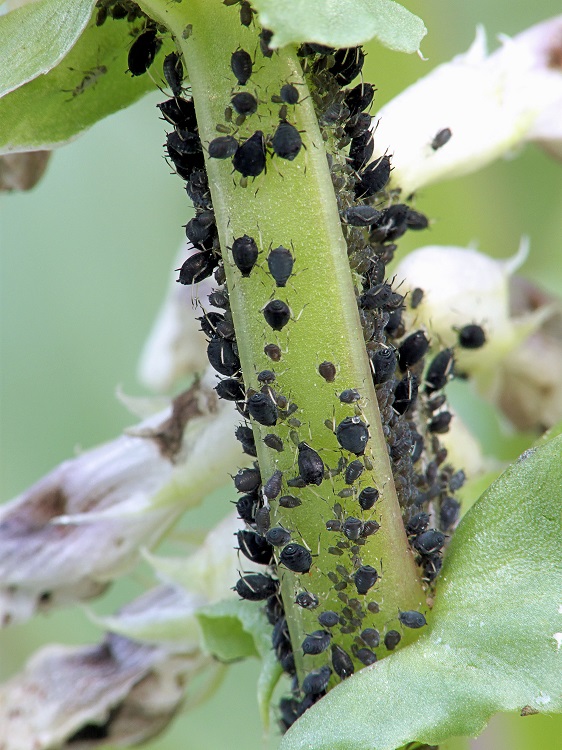 I get aphids pretty regularly and effectively kill them with [easyazon_link identifier=”B075KJK11C” locale=”US” tag=”edibleterrace-20″]insecticidal soap[/easyazon_link]. This is a common recommendation. Something else you can do is plant flowers that attract beneficial insects such as ladybugs and hoverflies. They feed on aphids. This is my preferred method and I have resolved to try it next season.
I get aphids pretty regularly and effectively kill them with [easyazon_link identifier=”B075KJK11C” locale=”US” tag=”edibleterrace-20″]insecticidal soap[/easyazon_link]. This is a common recommendation. Something else you can do is plant flowers that attract beneficial insects such as ladybugs and hoverflies. They feed on aphids. This is my preferred method and I have resolved to try it next season.
Some plants that attract these beneficial insects are sweet alyssum, zinnias, nasturtiums (edible BTW), cosmos and zinnias. In fact, not killing off all the aphids means those new helpful friends of yours will stick around-because you’re such a good host-giving them all that free food!!
[easyazon_link identifier=”B07WNKGSMV” locale=”US” tag=”edibleterrace-20″]Click here to buy live ladybugs on Amazon.[/easyazon_link]
Spider Mites

Source: https://flic.kr/p/qa3KbK
Spider mites are really, really small so it is very hard to detect them. Instead, you see the damage. Insecticidal soap works for killing them too.Additionally, attracting those beneficial insects is well, beneficial.
Whiteflies
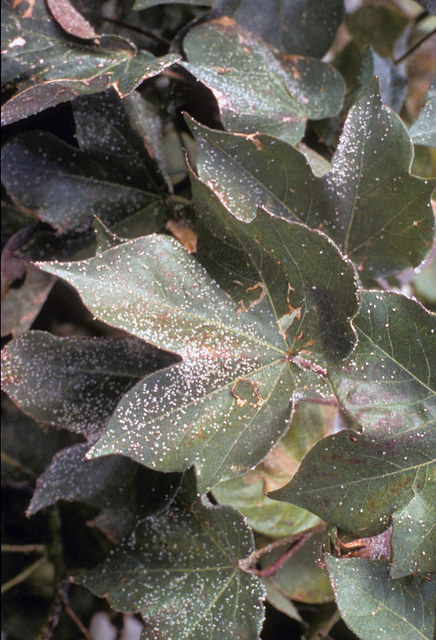
Whiteflies
Source: https://flic.kr/p/dt8PiQ
Spraying insecticidal soap is also effective in killing whiteflies.
Small warning on using insecticidal soap
Be careful in your enthusiasm to kill those little nuisances. Insecticidal soap can be mildly toxic to your plants. Some tidbits of advice.
- Spray only every four to seven days
- Dilute the spray even more than is recommended on the instructions (assuming you buy commercial insecticidal soap).
- If you have hard tap water, use rainwater or distilled water instead. The chemicals typically found in hard water can actually damage your leaves.
- If possible, buy a commercial soap (versus DIY) as they were specifically created to be sprayed on plants.
Having said that, I did make my own spray and it did kill the aphids. I believe I may have killed a few spinach and pepper leaves in the process but definitely not the whole plant.
[easyazon_link identifier=”B075KJK11C” locale=”US” tag=”edibleterrace-20″]Don’t want to deal with making your own insecticidal spray? Buy it here.[/easyazon_link]
Overwatering/Underwatering
I talk about this quite often. I was terrible at the whole watering thing-until I bought my moisture meter. That whole thing about sticking your finger in to see if the soil felt moist enough just did not work for me.
I am sure this skill comes with many years of practice. My moisture meter has helped me keep my plants alive far longer! Nuff said.
Don’t throw all your hard work away. Buy yourself a moisture meter. Best $10 you’ll ever spend!
Another thing we did (well, K really) was to install a drip system in the greenhouse and in my raised beds. My friend Jen has an incredible veggie garden on her 10 acres in East Tennessee right up against the Smokies. 🥰 She is totally in love with the tripod sprinkler from Tractor Supply and has them strategically placed around her garden.
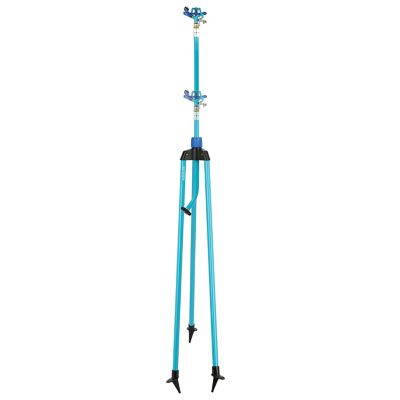
Aqua Joe Indestructible Zinc Impulse 360-D…
Aqua Joe Indestructible Zinc Impulse 360-Deg. Telescoping Tripod Sprinkler, Customizabl… [More]
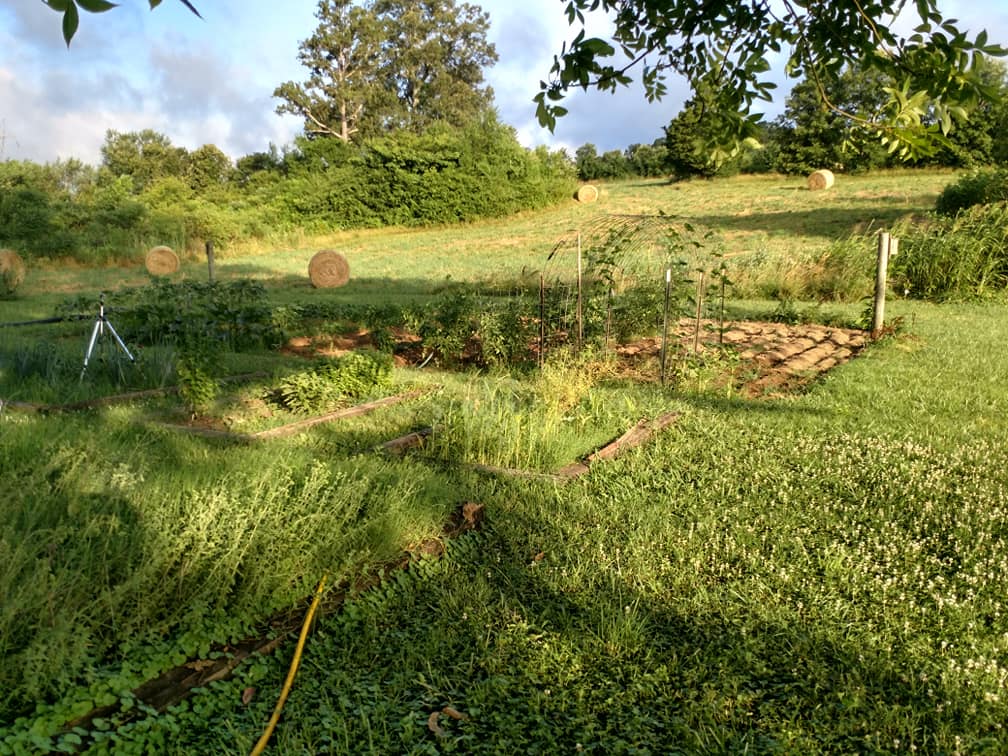
My friend Jen’s gorgeous East Tennessee garden

A close-up of her tripod sprinkler
Not Enough Sun
Yet another cause for the problem of why my plants leaves are turning yellow!
This is a tough one too. Plants (especially vegetables) typically need an average of 6 hours of sun every day. Having said that, some plants like root vegetables can handle some shade. Additionally, you do not want to burn the plants. Not helpful either. If shade is a problem, can you move your plants to containers? Or can you trim your trees and shrubs to eek out as much sunlight as possible?
[easyazon_infoblock align=”right” identifier=”0881929611″ locale=”US” tag=”edibleterrace-20″]When we first moved to No Flo, before I planted anything, I took multiple trips over the course of several days walking out to our yard during varying times trying to decide which part of the yard got the most sun (We are surrounded on all sides by pine, oak, piñon, etc. Gorgeous really-just gets in the way of growing my edibles.).
This actually turned out to be quite wise because the one part of our yard which seemed to be the most natural place to put the greenhouse was the worst for sunlight. The greenhouse needs to have a long side facing south without any obstruction. We had to do some serious thinking and maneuvering to make that happen but my plants are doing great in there.
Now that you’ve got the scoop…
Well, now you know how to solve the problem of vegetable plant leaves turning yellow. There is not one simple answer but thankfully there are fixes and remedies for all of the issues.
- For a nitrogen deficiency, supplement with either compost with manure in it or [easyazon_link identifier=”B01CI33HJ2″ locale=”US” tag=”yellow-leaves-20″]fish emulsion[/easyazon_link].
- For a potassium deficiency, use either fish emulsion, [easyazon_link identifier=”B073ZNW8MX” locale=”US” tag=”yellow-leaves-20″]liquid seaweed[/easyazon_link] or kelp meal.
- For an iron deficiency, a good compost with chicken manure and seaweed will help.
- Do you have pests? [easyazon_link identifier=”B075KJK11C” locale=”US” tag=”yellow-leaves-20″]Insecticidal soap[/easyazon_link] will kill them. For aphids, live ladybugs are a great beneficial insect to add to your garden as well (and WAY less maintenance and expense than those chickens you have!)
- Is watering an issue? For those of us who container garden, overwatering is frequently a problem. I recommend this [easyazon_link identifier=”B00PTLGKSQ” locale=”US” tag=”yellow-leaves-20″]moisture meter[/easyazon_link] to help track that. Are you underwatering, get my friend Jen’s tripod sprinkler from Tractor Supply (shown above) and save yourself hours of watering by hand.
- Not enough sun? Start shifting your plants (as much as you can) over to south facing areas of your outside area. If that won’t work, then how about some [easyazon_link identifier=”B01JLKUA2W” locale=”US” tag=”yellow-leaves-20″]grow lights[/easyazon_link]. K and I use the grow lights to start our seedlings in January either in the house or in the greenhouse.
My final love message. Be very methodical about how you solve this problem. You want to research carefully (especially when trying to fix the soil nutrients) before throwing a bandaid on the wound. Then document, document, document because I promise youwillhavethissameissue next year and will be VERY grateful you kept a record of what you did!
Congratulations! You made it all the way to the end! I am always learning and very interested in how others solve their gardening problems. If you were able to solve your yellow leaves issue, please leave a comment below let me know how and what you did so I can learn from you too! 👩🏽🌾
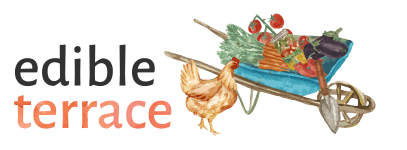

Great article! Bring on spring!
Yessss!!!
Wow, I didn’t know any of this. I’m a terrible gardener. I stick it in the ground and hope it grows. This will be very helpful this spring! Thank you.
Haha! I am not too far off from that! Always learning!!